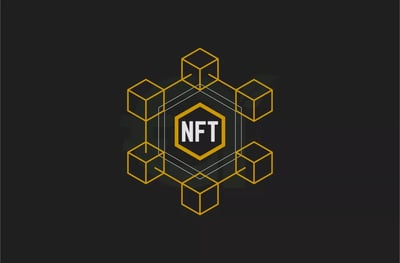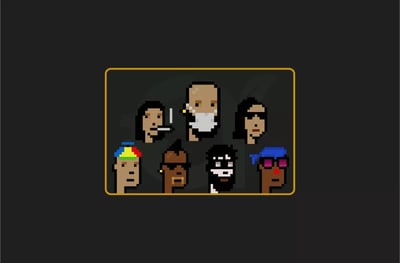Non-fungible tokens, or NFTs, as the acronym goes, have been a hot topic in recent times. These exciting art-based digital assets are a relatively new addition to the still emerging cryptocurrency space. NFTs can cost as little as a few dollars, or as much as several millions of dollars. NFTs are based on the tokenization of digital assets, so they can take the form of games, art, photography, music, memorabilia and much more.
NFTs operate on a scarcity model, in that they are not necessarily a required basic commodity, like foodstuffs, but they are purchased by individuals who are attracted to their subjective value. We will cover more on that later. With this being such a new area, there are undoubtedly many myths and gray areas, especially around how you can invest in NFTs. With that in mind, we have prepared this article to explain the most important details of how you can safely invest in NFTs.
Key Takeaways
NFTs are unique digital assets that use blockchain technology to certify ownership and can range from artwork to video clips to domain names.
The value of an NFT is subjective and based on buyer sentiment, making it a risky and speculative investment.
NFT buyers are often motivated by exclusivity, community involvement, creator support, or the potential for resale profits.
Before investing, it's essential to research NFT trends, assess the creators behind the collections, and join community chats to gauge market sentiment.
You need to purchase cryptocurrency, usually Ethereum, through a brokerage or exchange like Coinbase, Gemini, or Binance before you can buy NFTs.
Marketplaces such as OpenSea, Rarity.tools, and Rarible allow users to browse, bid on, and purchase NFTs, with varying structures for auctions and flat sales.
NFT ownership is stored in crypto wallets like Cybavo or Trust Wallet, with hot or cold storage options depending on user preference.
Investors should be cautious of fees, environmental concerns, and the lack of guaranteed returns, especially as NFT values can drop sharply without warning.

What are NFTs?
NFTs are non-fungible tokens, which is an item that cannot be duplicated and is, therefore, unique. The first NFTs were created as far back as 2014, but the NFT concept has just recently taken off in popularity. These tokens are digital versions of items of value and interest, such as art, memes, music, videos, and in-game purchases. NFTs use the same blockchain technology as cryptocurrencies to complete the encoding of who owns the NFT. Most NFT marketplaces use Ethereum (ETH) cryptocurrency to deal in NFTs. As the space opens up, some newer marketplaces may use other cryptos, like Polygon, Solana and Polkadot.
How do NFTs actually work? The traditional art world of paintings and sculptures shares many commonalities with the NFT world. An original painting is another example of a non-fungible asset. The painting is the only one of its kind and it cannot be reproduced. Naturally, prints can be produced, but there is only one original.
Fiat currency is an example of an item that is fungible. It can be produced in large quantities of seemingly identical notes (except for the serial number, of course). However, a fiat currency is fungible in that you can exchange a particular dollar bill for another dollar bill, and not be any better or worse off.
Now, you might point out that many well-known NFTS, such as digital images of monkeys in the Bored Ape series, can be duplicated in much the same way as dollar bills. Digital assets can be re-created in unlimited numbers, so where is the value if most NFTs can be copied and shared?
The industry attempts to solve the problem of non-fungibility and uniqueness by creating scarcity and designating a digital creation as the “original.” If you own an original NFT of any digital asset, then there are ways to prove you own it. Using unique coding and digital records of authenticity, you can prove that an NFT belongs to you, even if it can be reproduced easily. Many onlookers question what the big deal is about owning the original. Just like in the art world, there is only one Mona Lisa, even though there may be many prints. The item derives its value from being probably the one true original. In the NFT world, it is more than just bragging rights, it is the proof of uniqueness that keeps the value of the item.
In 2021 alone, a total of around $41 billion worth of crypto was used to acquire NFTs. Renowned digital artist Beeple sold his "EVERYDAYS: The First 5000 Days," for a staggering $69.3 million. In the next section, we will try to understand how an NFT can fetch such a sum.
What Makes NFTs Valuable?
NFTs are only worth as much as buyers are willing to pay for them. This means they have no intrinsic value and are not part of an organized market in which other NFTs are categorized and priced. This is to say that there is no harmonized pricing method in the way you could price pumpkins by size, weight and color. The value of an NFT is totally subjective. Thus, the decision to purchase an NFT is largely down to how much value the buyer ascribes to the item in their personal opinion.
NFTs are different from productive financial assets like stocks and shares that yield shareholder dividends or projected earnings based on company performance. NFTs are passive assets that may gain value purely through buyer sentiment. Why invest in NFTs? Well, one reason is that you get exclusivity. You buy the right to say you own the original of a digital artwork that cannot be copied (you should know that the artist can still retain the copyright and reproduction rights, even if you own the original). It goes back to the issue of bragging rights, which is important for some people.
Other reasons that people buy NFTs are to support the creators who make these digital assets. Digital creators, like painters and sculptors, are often only concerned in producing their art for the purity of creation. They are most often not able or even interested in navigating the commercial aspects of selling their work, opening themselves up for exploitation. Artists have often existed on the outside of the systems their artworks drive. NFTs allow creators to retain control of their artworks and even receive royalties if their art is sold to other people. This so-called “secondary market” has always been a bone of contention for creators of physical artworks, who typically only get to sell their artwork once, yet well-connected and monied collectors can on-sell their art many times. They can do this by selling and rebuying the same artwork, often fetching far more than the original artist earned. By investing in NFTs, many people claim to be doing so to protect the interests of the creators.
NFTs have other useful aspects that make them a worthwhile purchase. With NFTs having the ability to provide ownership for users that will authenticate their ownership rights, digital assets can be stored and transported more easily than any set of physical collectibles. You may not have realized it, but for collectors of physical art, storage, transportation, maintenance (many artworks must be professionally cleaned) and insurance of these valuable assets are areas of big concern for their owners. In the digital world, most of these issues are solved. For all the advantages of NFTs, some people still feel they are a vanity project of the super-rich who delight in collecting new toys.
Why Invest in NFTs?
Besides the new forms of convenience, and besides the altruistic urge to support the artistic community, why should you invest in NFTs? Many people believe in the investment potential of this sector. As the marketplace grows, the potential for exchange and resale will become vast. Let’s face it, not all of us are artistic experts, and the average investor may be unimpressed by the merits of a Bored Ape image. However, you do not need to enjoy the artwork to make a smart investment you intend to cash in later. In much the same way that you invest in stocks but do not have a close affiliation with the companies behind them, you can buy a trendy NFT, not for its beauty, but for the chance to sell it for a profit later.
Four Steps to Investing in NFTs
If you are seriously interested in investing in NFTs, you will need to follow a few important steps. Here they are:
Do Some Research on Trending NFTs
To start, you should be looking to select an NFT that you can resell for a profit later. If you are an investor who takes a pragmatic approach to investment and is not only in it for the artistic merits of the NFT, then the resale value of the item should not be far from your mind.
There are ways to learn what artworks are available. For example, you could search Google or Twitter for NFTs. Subscribe to Websites like Rarity.tools or NFTcatcher.io that feature upcoming lists of NFT projects. A quick visit to these Websites will reveal the wide range of available NFTs. These markets are growing every day as more creators get in on the action and more buyers hear about the profit potential.
Over time, you will become familiar with ways to assess NFTs by finding out what the forthcoming NFT sale is, as well as what the cryptocurrency requirements are. You can also find out how many NFTs are being sold. When you are in tune with the market, you can develop a better eye for a deal.
There are many important considerations you will need to understand about the NFT you are about to buy. For example, which creation team is behind the NFT? Is the team well-regarded? Also, how large is the project? To take full advantage of the tokenization aspect of NFTs, many creative teams create large-scale projects featuring thousands of related NFTs. For example, on Rarity.tools, “Notorious Kings” is a themed project featuring 3,600 images for wildlife enthusiasts and NFT collectors. This information is important for the future selling prospects of any item you purchase as collectors normally wish to own as much of a collection as possible, and if you buy crucial parts of an NFT series, you can sell them to collectors.
There are also ways to become steeped in the project, such as joining social media chats, to understand what the sentiment is about the quality of this line of NFTs. When you are part of the community of an upcoming NFT release, you can get a sense of the level of excitement about the project and the kinds of buyers who will be taking part in the auction.
You will need to understand terms like whether the sale is on-chain or off-chain. On-chain transactions take place on the blockchain and are available for public view and tracing. Off-chain transactions take place off the blockchain, but are instant, anonymous and free of on-chain fees.
Choose a Brokerage or Exchange to Buy Crypto
Once you have chosen the NFT you want, you will need to source crypto to buy it. ETH supports most NFTs and is the crypto backbone of the NFT market. However, ETH is not the only crypto used in the NFT world. You can use other cryptos, like Solana. Some examples of popular specialized crypto exchanges include Coinbase, Robinhood, Gemini, Binance or Kraken.
Here are some key terms you need to understand before you invest:
Cryptocurrency Brokerage: This is normally a company that acts as the intermediary between the buyer and the rest of the cryptocurrency market in the purchase of crypto coins. To start your investment journey, buy your ETH from a reputable cryptocurrency brokerage using as little as $10. Buying ETH via a brokerage is simple. You will need to open an account, pass the KYC process, and make a deposit in a fiat currency. You can usually fund your account with all the main methods, such as Credit/Debit Card, bank transfer, or electronic wallet. From there, you simply need to search for ETH to buy and complete the exchange with the prevailing fiat currency amount.
Cryptocurrency Exchange: This is an online platform that allows buyers and sellers to trade among each other on a peer-to-peer basis. In such a marketplace, you can buy ETH from sellers around the globe. These exchanges normally have a streamlined platform that allows you to buy the crypto you need in minutes. They offer increased security as they don’t control your personal information.
As the market develops, there are increasing numbers of ways to buy cryptos like ETH. Depending on where you live, you can simply find an ETH ATM in your area. By searching online, you can see if there is such an ATM close by, and you can use your digital wallet to complete the purchase in person.
Whichever method you use, pay attention to fees. Processing fees can rack up quickly, so make sure you know what you are paying for before you decide to place an order for ETH.
Choose a Marketplace to Buy your NFT
You now need to find the best marketplace to source your NFT. When you have selected the best marketplace, you will need to register and connect your c
rypto wallet. We will discuss the best NFT wallets for crypto storage in the next section. Each marketplace operates differently. For example, some NFT marketplaces sell NFTs for a flat fee and some determine their prices through an auction process.
Some of the best-known marketplaces include OpenSea, Larva Labs, Rarity.tools and Rarible. You should ensure your wallet is correctly capitalized to complete the purchase of the item you are buying. You will need to account for the amount of crypto to buy the item, as well as any fees.
Fees relating to the purchase of NFTs include the cost of buying the NFT and transferring crypto coins. There may be a process involving converting between cryptos, and even a cut for crypto miners (known as gas fees) whose job it is to record transactions on the blockchain. A pro tip is that the listed price or bid price for an NFT is normally less than what you will pay once fees are accounted for.
The NFT world is constantly evolving, but let us look at the assets you can currently find on the market:
Artwork. These form the bulk of the NFT market, and they include digital art, animations, pixel art, GIFs, paintings, photography and multimedia items.
Music. In a way, musical tracks are the original NFT. Musicians strived to own the original recording of their music and receive royalties every time it was played or used on a production, like a movie. In truth, the musicians themselves did not retain such control, this was the purview of the recording label. Today, recording artists can sell original tracks, remixes and collaborations through NFTs, and further, they can create high-quality material and make a living while working independently of recording labels.
Digital assets. These are usually gaming skins and avatars created by designers and sold as NFTs.
Trading cards. NFT trading cards are a lot like physical trading cards that are traditionally used to commemorate events and public figures. Some trading card collections are vast, featuring thousands of cards.
Domain names. To save anyone sending you crypto the trouble of inputting a complex string of alphanumeric characters to access your address, you can buy a simplified domain name that is like a Website URL.
Miscellaneous. The NFT marketplace is always growing. More and more items can be tokenized. Think of tweets, memes and viral video clips. These can all be sold as NFTs.
Remember that if you enjoy a creator’s work, they likely have a larger collection than what you are seeing. Many NFT marketplaces have verified creators whose work they promote as part of their stable. As always, if you are in it to support the artist, make sure that when you buy an NFT, you are buying it directly from the artist themselves. Remember the secondary market we spoke about? This is where collectors snap up the work of emerging artists and re-sell it for a profit. You could be buying the piece from someone like this while believing you are helping the creator. Note there is nothing inherently wrong with buying artwork with the intention of reselling it. This could be your goal as an investor.
Choose a Crypto Wallet to Store your NFT
Once you buy your NFT, it gets stored in your crypto wallet. Remember, your proof of ownership comes in the form of strings of numbers that you will need to keep safe. No matter the value of your NFT portfolio, you do not want to have your assets stolen. You want to store your NFT details as carefully as you would actual crypto, so be sure to choose the right wallet.
You can keep your NFTs in a crypto wallet on the same blockchain as your crypto coins, on another blockchain altogether, or in decentralized storage via a physical device. Examples of crypto storage wallets for NFTs include popular options like Cybavo, Trust Wallet, and Alpha Wallet.
These specialized wallets permit the safe storage of your crypto as well as the NFTs that you purchase from the marketplace. You can enable hot storage on the Internet, or cold storage off the Internet Alternatively, you can utilize an external hardware wallet not unlike a USB memory stick.
Should you Invest in NFTs?
NFTs are a risky investment. They are only worth whatever the next owner is willing to pay for them. Therefore, if you cannot find a market for your NFT, and you parted with significant funds to own it, they are a bad investment. Don’t buy NFTs as an investment when you cannot afford to lose that money.
The decision of whether to buy NFTs should be interrogated closely. Ask yourself why you are investing. If your plan is to make extra money, build a passive income, or even save for a rainy day, then NFTs are not the best investment because they are highly volatile. A period of sustained growth could be followed by a sudden drop in overall prices. For more stable earning methods, investigate traditional financial assets, like index or mutual funds, exchange traded funds (EFT), or even real estate.
If you are less interested in NFTs as an investment vehicle, but you are truly interested in digital artworks, or rare collectibles, then you will get your fix from NFTs. However, it is rare to find an investor who wants to buy NFTs for the mere sake of it. Even buying NFTs to support the creative community is a luxury many people do not have. It is more likely that you want to get some measure of profit by paying close attention to trends and finding out what is a high-demand NFT. It takes time and effort and a deliberate strategy to make money this way.
Pros and Cons of Investing in NFTs
You should always balance possible advantages versus disadvantages before you invest in any asset. NFTs have the attention of many investors as their value has increased in the recent past, creating a lot of excitement in the investing community.
Pros
NFT value can appreciate markedly. With the buzz in the market, these assets can appreciate a lot in a short space of time.
The number of market participants will increase. Due to the popularity of NFTs, we are probably only scratching the surface of what the market could become. This means more opportunities to make money in the future.
Another advantage is the increase in technology behind NFTs, meaning that with items, such as smart contracts, not only are NFTs kept safe, but artists can also stay in the value chain and get commission on future sales. When a marketplace protects all role-players, it tends to have a future.
With millions of NFTs on the market, there will likely never be a shortage of inventory. With a steady flow of inventory, you can plan your strategy for the long term.
Cons
Many people believe the value of NFTs may not remain high forever. Not all NFTs can hold their value for prolonged periods, so there’s always a risk you will lose on your investment at some point. People in the art world reference the fact that many of the grand artists like Jackson Pollock and Mark Rothco were important to their era as they moved the art world forward by pioneering new and significant technical methods. Therefore, they were culturally important, thus justifying the prices their pieces fetched. There is little of the same cultural importance to most NFTs, leading some to question their future value when the novelty wears off.
You must always be careful of fees. Every time an NFT is sold, you will likely have to pay a fee to some or other party, be it currency conversion fees or gas fees.
All things related to blockchain come with a high environmental impact. Maintaining the blockchain and mining the cryptos related to NFTs takes a lot of energy that often uses fossil fuels.
NFTs cannot generate value on their own, so their value will always be at the subjective whims of buyers. NFTs are also intertwined with the cryptocurrencies, meaning that if the crypto market crashes, there will be no easy way to buy NFTs.0
Another important disadvantage of the NFT market is that folks without technology backgrounds often have trouble understanding what they are all about. This hampers the growth of the community.
How to Sell NFTs
After buying NFTs as an investment, there will come a time when you are looking to sell.
Resold NFTs
Once you buy your NFT, you can always resell it when you are ready. This can be a profitable exercise if you get your timing right. In the same way you bought your NFT on a market, you can resell it on the same marketplace. You will have to pay a small fee for putting your NFT in the shop window. There is often a verification process that involves the marketplace confirming that the NFT is yours.
Most marketplaces have an easy-to-follow method on their platform that allows you to put your items back on the market and start receiving offers. As the value of ETH and other cryptos is always fluctuating, the NFT you bought for a certain amount could have appreciated and be worth a lot more now (or less). However, the upside lies not only in making money from the appreciation of the crypto, but also in the possibility that there is more demand for your NFT. You would hope that when you are ready to sell you will make a profit.
Your Own Original NFTs
If you want to sell your own NFTs, the process is a little more complicated. First you must create the item you intend to sell, whether that is a piece of digital art or photography. Then, you must decide which cryptocurrency you want to sell the items in. As we have mentioned, ETH is the way to go as it is most compatible with online marketplaces and wallets.
When your NFT is ready to be sold, upload it to the marketplaces of your choice. Remember those gas fees? This is one of the times you will have to pay a gas fee to a miner for the cost of transferring and keeping your NFT on the network. Be sure to sell to a marketplace that gives you the option to earn royalties every time someone sells your NFT to another buyer. To get your item onto the marketplace, you may have to pay a special fee just to get your NFT loaded and hosted. With time, mastering this process becomes easier. Also, as you start to understand the effect of the various fees on your takings, you will become better at pricing your work.
Conclusion
NFTs are on the up. Their value is elusive as it is up to how much the buyer wants to spend on them. However, if you study trends well, you could buy an NFT at a good time and sell it for a good profit. Remember the steps we have discussed about how to go about buying an NFT. You must buy the right crypto, choose a wallet, and choose a marketplace, all this before you can even decide on what NFT to buy. Don’t lose sight of the fees you must pay and be aware at every stage that this growing market can devalue any time.
FAQ
How much can you make from selling NFTs?
There are always stories about how people have made a lot of money from NFTs. The truth is that the market is not as liquid as you might think. If you imagined making tens of thousands of dollars from NFTs, you need to think again. Most NFTs sell for much less than that, in the order of a few dozen dollars. Only the most popular NFTs that have become viral will sell for a lot of money. Also, famous NFT artists are much more likely to sell their work than will you as a beginner. The fundamentals are not much different than the real art world or the music world – until you get a big break, you will struggle to make real money from your efforts. As we have mentioned, you also must pay attention to the fees required to mint your work and for gas fees.
What is the future of NFTs?
NFTs are a new and exciting part of a growing but unpredictable market. It is difficult to speculate how profitable they will be in the future. The good news is that more and more people are trying to learn about NFTs so they can play a part in the market as creators or buyers. NFTs are no longer as niche as they once were. Like all types of investments, buying and selling NFTs comes with risk.
Are NFTs a good investment?
It is very difficult to predict the future of NFTs. There is no denying that NFTs are currently enjoying their day in the sun because of positive trends and good sentiment. How long it will last is not something that is easily answered. However, like cryptocurrencies, NFTs are an exciting part of our digital future, meaning that prices may well continue to appreciate as the market matures and takes on more entrants. As yet undiscovered advancements in technology could make NFTs even more profitable and valuable than they are today. On the other hand, it could all be a bubble that bursts eventually. Nothing is guaranteed.
Can I become an NFT broker?
Sensing an opportunity to be more than a small-time NFT dealer, some people are investigating what it takes to become an NFT broker. If you are an NFT broker, you create and own a marketplace where people buy and sell NFTs. In practice, this is achievable, as you simply need a secure and robust website that can handle high numbers of users, assets, and Website traffic. You could diversify your earning streams by charging NFT artists to upload their work. Remember those pesky gas fees? Well, you could charge a gas fee yourself.
Many people are attracted to running a brokerage business because the crypto space in general is more welcoming to new entrants than established industries in the real world. The barriers to entry are not that onerous, and you could easily set up your brokerage business. Before you go too far down this path, remember that becoming an NFT broker requires essential knowledge about running a business, operating a Website and knowing how NFTs and blockchains work. You will also need to live with some level of risk since NFTs and cryptocurrency are a relatively new form of technology.








